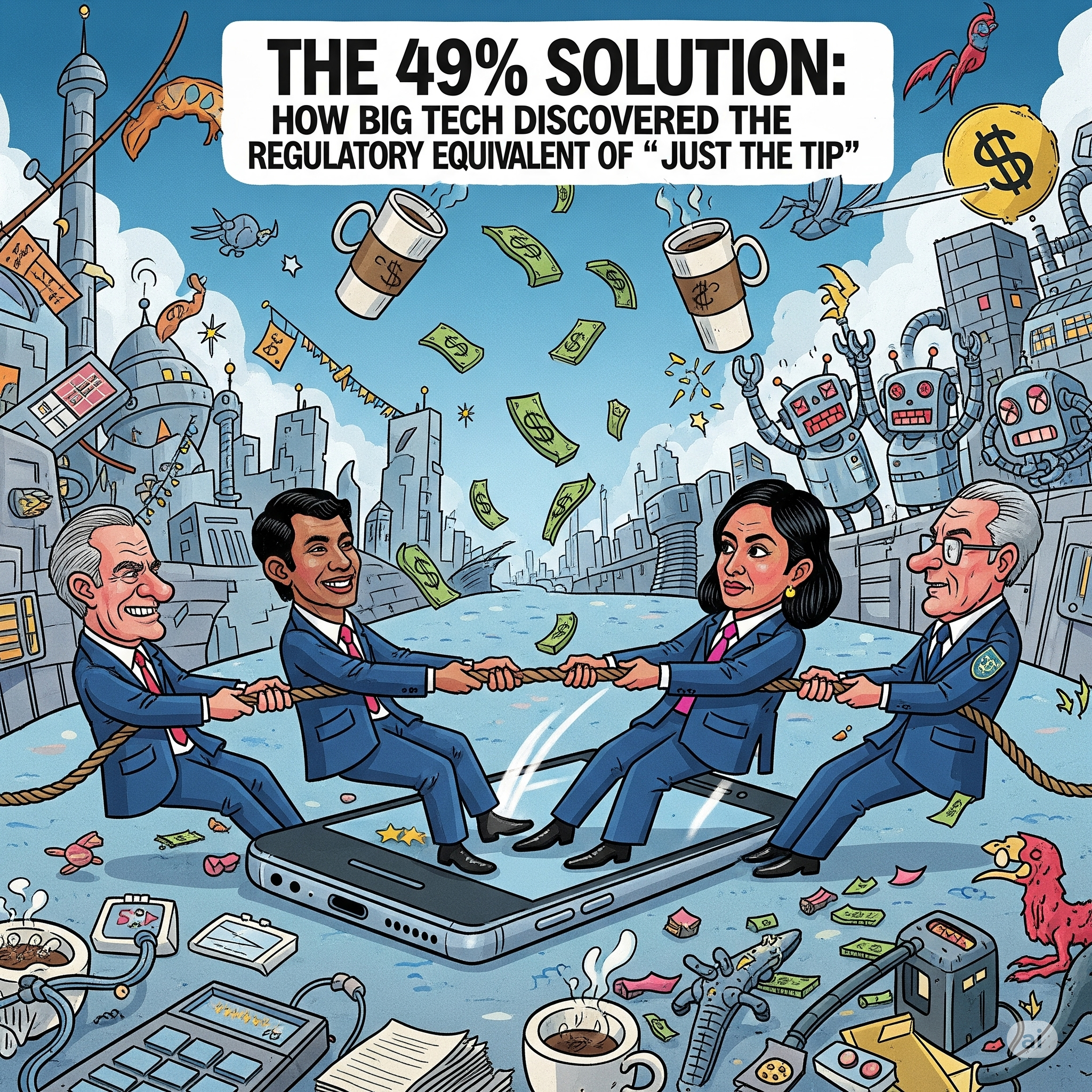In which Silicon Valley’s finest legal minds prove that antitrust law is really just a creative writing exercise!
The most brilliant minds in Silicon Valley have finally cracked the code that has eluded philosophers, mathematicians, and divorce lawyers for centuries: the precise mathematical threshold where ownership becomes “not really ownership.” Through exhaustive research involving armies of $10,000-per-hour lawyers and enough cocaine-fueled all-nighters (or ‘benders’ as they call them on the other side of the ocean) to power a small cryptocurrency mining operation, Big Tech has discovered that 49% is apparently the magical number where monopolistic behavior transforms into “strategic partnership synergies.”
Meta’s recent acquisition of 49% of Scale AI represents a masterclass in what industry insiders are calling “Schrödinger’s Acquisition”—simultaneously owning and not owning a company until a European regulator observes the transaction. It’s a quantum leap in corporate strategy that would make Werner Heisenberg weep with pride, assuming he could determine both his emotional state and his position relative to Mark Zuckerberg’s metaverse ambitions.
The beauty of this approach lies in its elegant simplicity. Why engage in messy, expensive anti-trust battles when you can simply purchase 49.9999% of a competitor and then spend the next fiscal quarter explaining to confused TechCrunch journalists that you’re merely “deeply committed strategic partners” rather than “a hydra-headed monopoly that would make David Rockefeller’s Standard Oil blush”? It’s the corporate equivalent of claiming you’re not really dating someone—you’re just exclusively sharing bodily fluids and joint bank accounts.
The Art of Almost-Ownership
Google’s rumored pursuit of Character AI follows the same playbook, though with the added sophistication of a tech company that has spent decades perfecting the art of claiming they’re “not evil” while simultaneously knowing more about your bathroom habits than your gastroenterologist. The search giant’s interest in Character AI—a platform that lets users chat with AI versions of celebrities, historical figures, and presumably their own crushing existential dread—represents the natural evolution of Google’s mission to organize the world’s information and then monetize your loneliness.
The proposed acquisition structure would allow Google to maintain plausible deniability about controlling yet another AI company while ensuring that Character AI’s technology integrates seamlessly with Google’s existing ecosystem of products designed to make you feel simultaneously connected and profoundly isolated. It’s a win-win scenario: Google gets access to cutting-edge conversational AI technology, and users get to experience the unique joy of having their deepest emotional conversations monitored by the same company that serves them ads for antidepressants.
Microsoft’s relationship with both Inflection and OpenAI demonstrates the true artistry of the 49% approach. Rather than outright purchasing these companies, Microsoft has crafted arrangements so intricate they require their own dedicated team of corporate archaeologists to decipher. The company has essentially created a new form of business relationship that exists somewhere between “strategic partnership” and “corporate Stockholm syndrome.”
The Inflection deal is particularly elegant in its complexity. Microsoft didn’t technically acquire the company—they simply hired most of its key personnel, licensed its technology, and created a working relationship so intimate that Inflection’s remaining employees probably receive Microsoft’s internal memos before some actual Microsoft employees do. It’s the corporate equivalent of claiming you didn’t steal someone’s car—you just borrowed their keys, driver, engine, wheels, and the general concept of automotive transportation.
The OpenAI Enslavement Paradigm
Microsoft’s relationship with OpenAI represents the pinnacle of 49% thinking taken to its logical extreme. Through a series of investments and partnerships so labyrinthine they require their own dedicated Wikipedia page, Microsoft has achieved something remarkable: complete operational control over a company they don’t technically own. It’s like having a goldren retreiver that pays rent and occasionally pretends to have free will.
The arrangement allows Microsoft to claim they’re simply supporting AI research while ensuring that every breakthrough OpenAI makes flows directly into Microsoft’s product ecosystem (Co-Pilot anyone?). OpenAI gets to maintain the illusion of independence while Microsoft gets to harvest the fruits of their labor like a particularly sophisticated digital sharecropping operation. Sam Altman can still give interviews about OpenAI’s mission to benefit humanity while Microsoft executives nod approvingly from the shadows, occasionally adjusting the puppet strings.
This model has proven so successful that other tech giants are scrambling to create their own versions of “technically independent but practically enslaved” AI companies. It’s the ultimate expression of Silicon Valley innovation: finding new ways to have your cake, eat it too, and then claim you were never really interested in cake in the first place.
The Regulatory Theater Performance
American regulators have responded to these developments with the kind of measured, thoughtful analysis typically reserved for determining whether water is wet. As long as the companies involved are American and generating domestic tax revenue, the regulatory response has been roughly equivalent to a parent watching their child play with matches while muttering, “Well, at least they’re being creative.”
The contrast becomes stark when Chinese or European companies attempt similar maneuvers. Suddenly, the same regulators who couldn’t spot a monopoly if it wore a name tag and handed out business cards transform into eagle-eyed guardians of competitive markets. TikTok’s mere existence triggers congressional hearings, while Meta’s acquisition spree receives the regulatory equivalent of a gentle pat on the head and a reminder to “play nice with the other children.”
This selective enforcement has created what economists are calling the “Homeland Monopoly Advantage”—the remarkable ability of domestic tech companies to engage in anti-competitive behavior while wrapped in the American flag and humming the US national anthem. It’s protectionism disguised as free market capitalism, which is itself disguised as innovation, which is ultimately disguised as serving consumer interests.
The European Union, meanwhile, watches these developments with the mixture of fascination and horror typically reserved for nature documentaries about parasitic wasps. European regulators have spent years crafting comprehensive digital market regulations, only to discover that American tech companies treat EU law like terms of service agreements—something to be acknowledged but not necessarily read or followed.
The Innovation of Regulatory Arbitrage
What we’re witnessing is the emergence of a new form of regulatory arbitrage that makes traditional tax avoidance schemes look quaint by comparison. Instead of simply moving money through offshore accounts, tech companies are now moving ownership through carefully constructed legal frameworks that exist in the gray area between “technically legal” and “morally questionable.”
The 49% solution represents the weaponization of mathematical precision against regulatory frameworks designed by people who still think “the cloud” is a weather phenomenon. Regulators crafted ownership thresholds based on traditional industrial models, never anticipating that tech companies would treat these limits like video game achievements to be unlocked through creative interpretation.
The result is a regulatory environment where the letter of the law is scrupulously observed while its spirit is systematically violated. It’s like following a recipe by using all the correct ingredients while completely ignoring the cooking instructions and then claiming you’ve made the same dish.
The Future of Almost-Ownership
As this model proves successful, we can expect to see increasingly sophisticated variations. Companies will develop new forms of “partnership” that involve everything except actual ownership: shared employees, integrated technology, coordinated strategy, and joint decision-making processes that stop just short of admitting they’re the same entity.
The logical endpoint of this trend is the emergence of corporate structures so complex they require their own dedicated AI systems to understand. We’ll see the rise of “Ownership Optimization Specialists”—lawyers whose sole job is to determine the maximum level of control a company can exert while maintaining plausible deniability about actually controlling anything.
Eventually, we may witness the creation of entire business ecosystems where no company technically owns any other company, but every company is somehow controlled by every other company through an intricate web of 49% stakes, licensing agreements, and shared coffee machines. It will be capitalism’s final form: a system so efficient at avoiding regulation that it accidentally regulates itself out of existence.
Have you noticed any particularly creative examples of the 49% solution in your corner of the tech world? Are you working for a company that’s technically independent but practically owned by someone else? Share your experiences with corporate quantum entanglement in the comments—we promise your overlords won’t mind, as long as they don’t technically own more than 48.9% of your soul.
Enjoyed this dose of uncomfortable truth? This article is just one layer of the onion.
My new book, “The Subtle Art of Not Giving a Prompt,” is the definitive survival manual for the AI age. It’s a guide to thriving in a world of intelligent machines by first admitting everything you fear is wrong (and probably your fault).
If you want to stop panicking about AI and start using it as a tool for your own liberation, this is the book you need.
>> Get your copy now (eBook & Paperback available) <<





GIPHY App Key not set. Please check settings